Analysis of Management and Leadership Practices at Marks and Spencer
VerifiedAdded on 2020/10/05
|14
|4653
|474
Report
AI Summary
This report delves into the management and leadership practices of Marks and Spencer (M&S), a major multinational retailer. It examines the company's organizational structure, comparing the roles and responsibilities of managers and leaders, and differentiating between managerial functions and leadership roles. The report applies various leadership theories, including situational, systems, and contingency theories, to the context of M&S, analyzing their strengths and weaknesses. It further explores the application of these theories in different situations, such as employee grievances and turnover, and provides recommendations for future improvements. The second part of the report focuses on operation management, its key approaches, and the roles of managers and leaders in improving operational efficiencies, considering the impact of the external business environment. Finally, it discusses the application of operations management within M&S and offers further recommendations for the company.
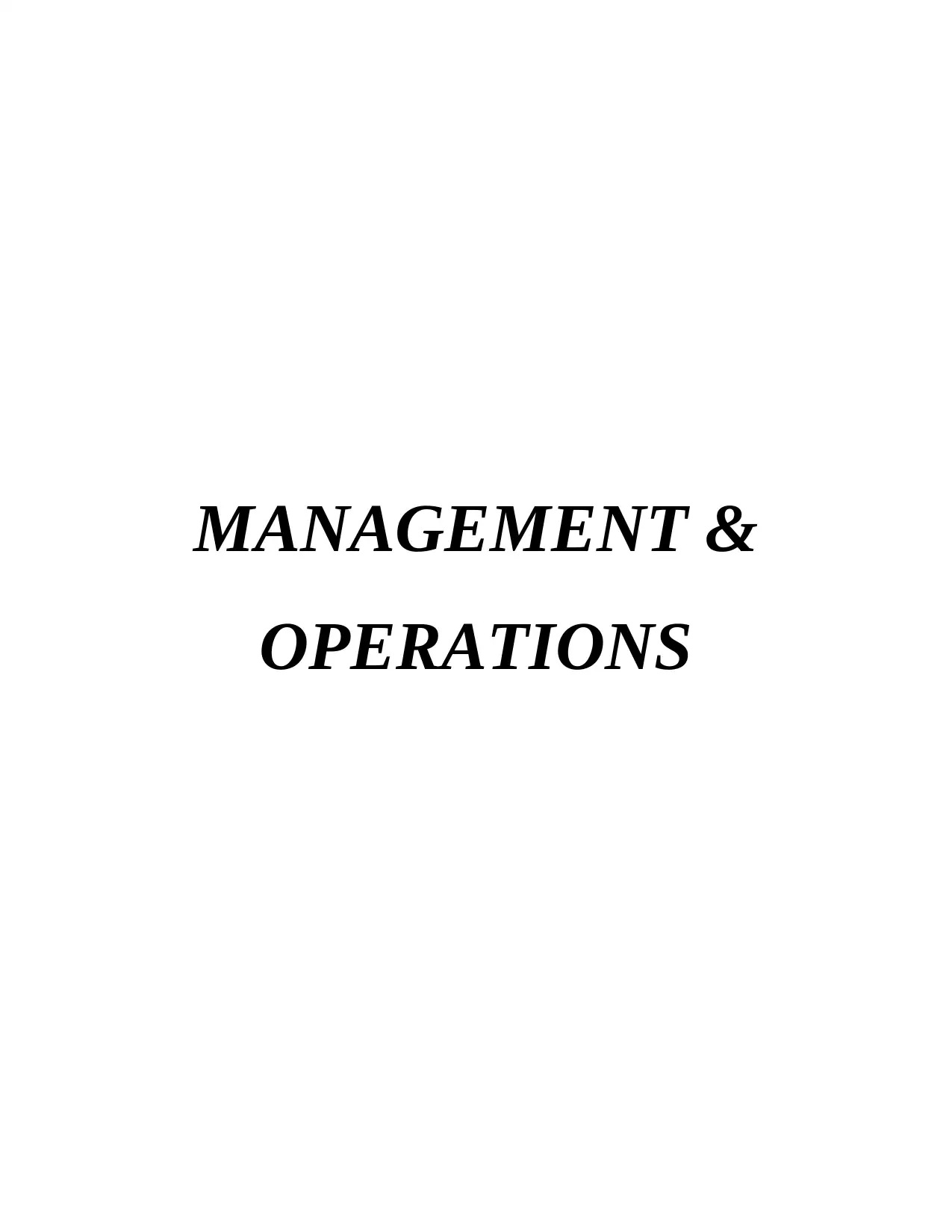
MANAGEMENT &
OPERATIONS
OPERATIONS
Paraphrase This Document
Need a fresh take? Get an instant paraphrase of this document with our AI Paraphraser
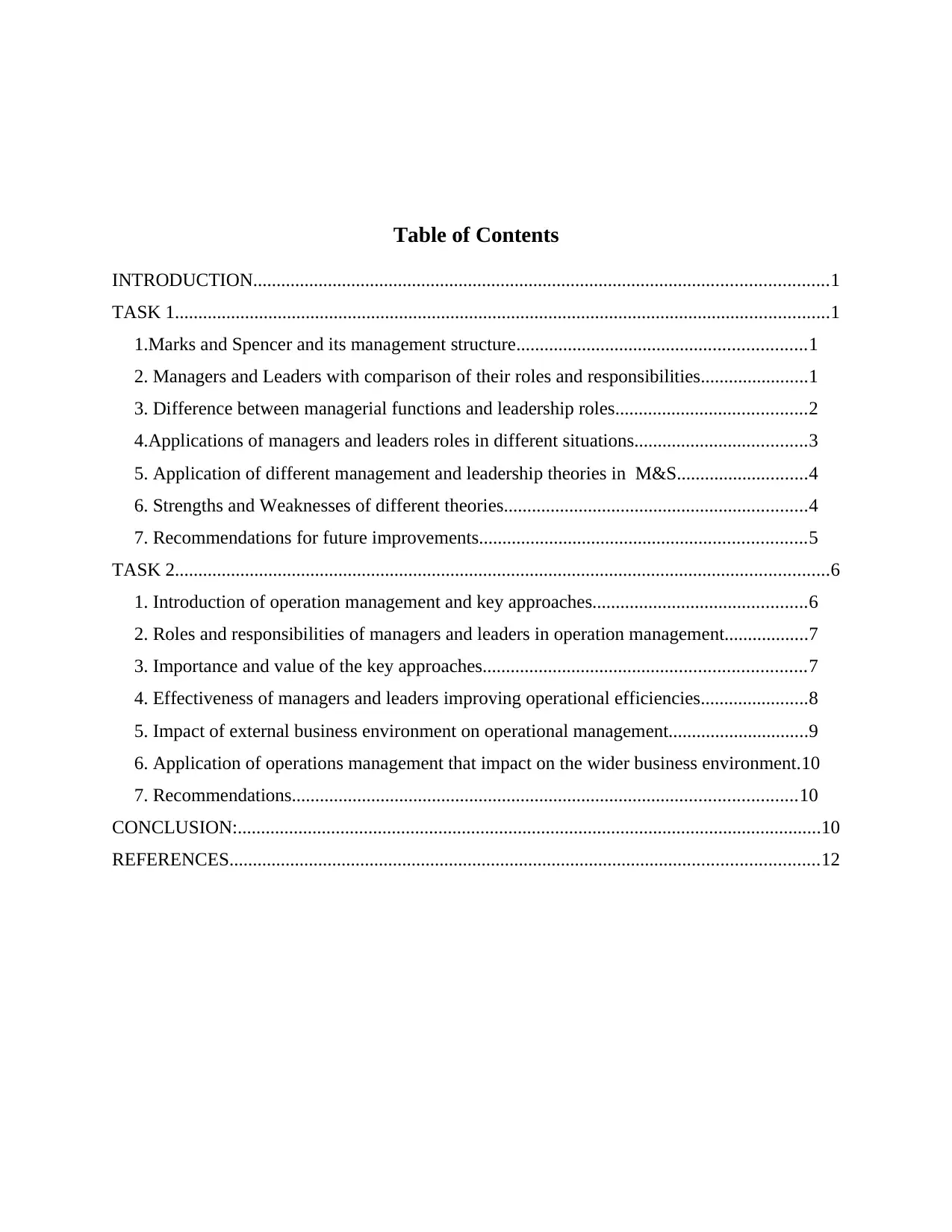
Table of Contents
INTRODUCTION...........................................................................................................................1
TASK 1............................................................................................................................................1
1.Marks and Spencer and its management structure..............................................................1
2. Managers and Leaders with comparison of their roles and responsibilities.......................1
3. Difference between managerial functions and leadership roles.........................................2
4.Applications of managers and leaders roles in different situations.....................................3
5. Application of different management and leadership theories in M&S............................4
6. Strengths and Weaknesses of different theories.................................................................4
7. Recommendations for future improvements......................................................................5
TASK 2............................................................................................................................................6
1. Introduction of operation management and key approaches..............................................6
2. Roles and responsibilities of managers and leaders in operation management..................7
3. Importance and value of the key approaches.....................................................................7
4. Effectiveness of managers and leaders improving operational efficiencies.......................8
5. Impact of external business environment on operational management..............................9
6. Application of operations management that impact on the wider business environment.10
7. Recommendations............................................................................................................10
CONCLUSION:.............................................................................................................................10
REFERENCES..............................................................................................................................12
INTRODUCTION...........................................................................................................................1
TASK 1............................................................................................................................................1
1.Marks and Spencer and its management structure..............................................................1
2. Managers and Leaders with comparison of their roles and responsibilities.......................1
3. Difference between managerial functions and leadership roles.........................................2
4.Applications of managers and leaders roles in different situations.....................................3
5. Application of different management and leadership theories in M&S............................4
6. Strengths and Weaknesses of different theories.................................................................4
7. Recommendations for future improvements......................................................................5
TASK 2............................................................................................................................................6
1. Introduction of operation management and key approaches..............................................6
2. Roles and responsibilities of managers and leaders in operation management..................7
3. Importance and value of the key approaches.....................................................................7
4. Effectiveness of managers and leaders improving operational efficiencies.......................8
5. Impact of external business environment on operational management..............................9
6. Application of operations management that impact on the wider business environment.10
7. Recommendations............................................................................................................10
CONCLUSION:.............................................................................................................................10
REFERENCES..............................................................................................................................12
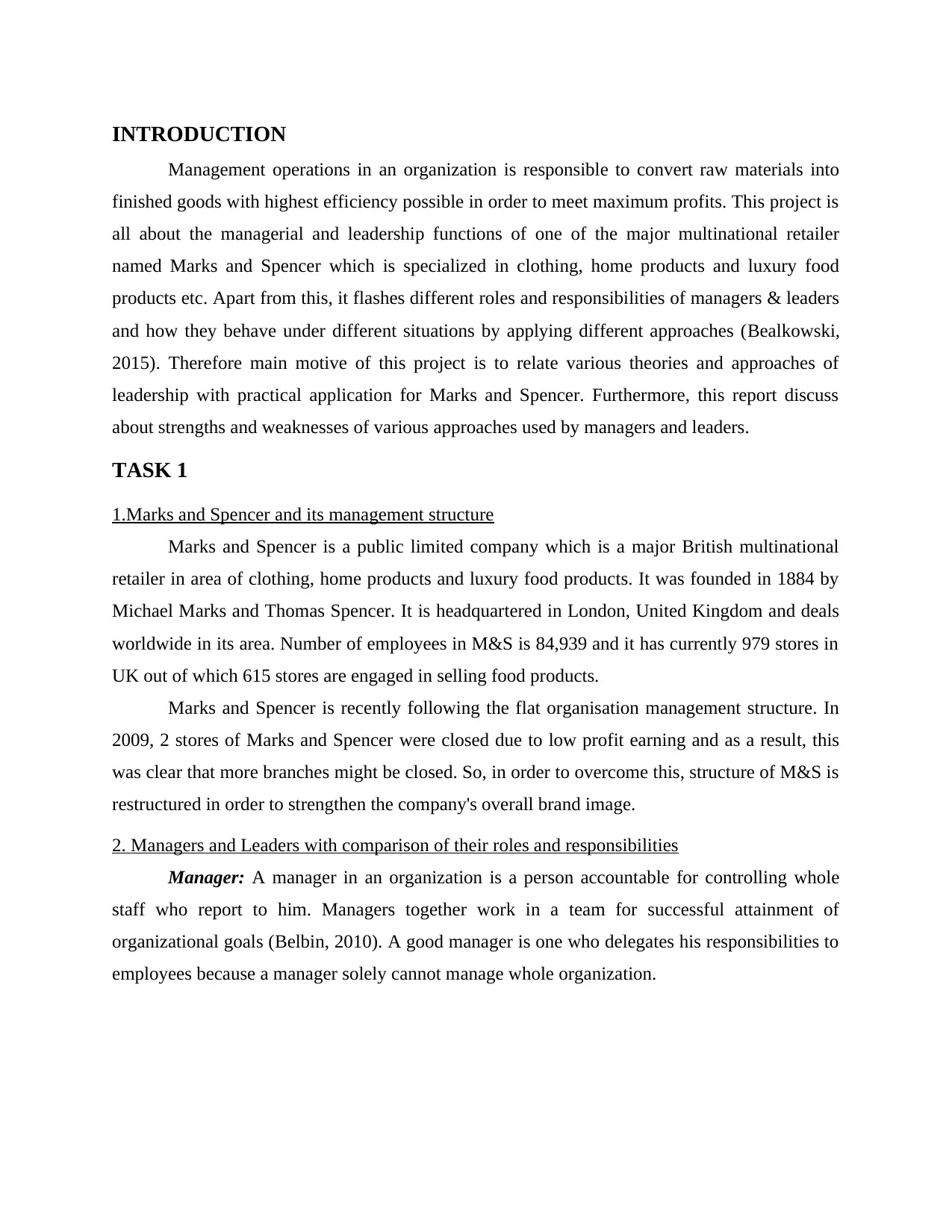
INTRODUCTION
Management operations in an organization is responsible to convert raw materials into
finished goods with highest efficiency possible in order to meet maximum profits. This project is
all about the managerial and leadership functions of one of the major multinational retailer
named Marks and Spencer which is specialized in clothing, home products and luxury food
products etc. Apart from this, it flashes different roles and responsibilities of managers & leaders
and how they behave under different situations by applying different approaches (Bealkowski,
2015). Therefore main motive of this project is to relate various theories and approaches of
leadership with practical application for Marks and Spencer. Furthermore, this report discuss
about strengths and weaknesses of various approaches used by managers and leaders.
TASK 1
1.Marks and Spencer and its management structure
Marks and Spencer is a public limited company which is a major British multinational
retailer in area of clothing, home products and luxury food products. It was founded in 1884 by
Michael Marks and Thomas Spencer. It is headquartered in London, United Kingdom and deals
worldwide in its area. Number of employees in M&S is 84,939 and it has currently 979 stores in
UK out of which 615 stores are engaged in selling food products.
Marks and Spencer is recently following the flat organisation management structure. In
2009, 2 stores of Marks and Spencer were closed due to low profit earning and as a result, this
was clear that more branches might be closed. So, in order to overcome this, structure of M&S is
restructured in order to strengthen the company's overall brand image.
2. Managers and Leaders with comparison of their roles and responsibilities
Manager: A manager in an organization is a person accountable for controlling whole
staff who report to him. Managers together work in a team for successful attainment of
organizational goals (Belbin, 2010). A good manager is one who delegates his responsibilities to
employees because a manager solely cannot manage whole organization.
Management operations in an organization is responsible to convert raw materials into
finished goods with highest efficiency possible in order to meet maximum profits. This project is
all about the managerial and leadership functions of one of the major multinational retailer
named Marks and Spencer which is specialized in clothing, home products and luxury food
products etc. Apart from this, it flashes different roles and responsibilities of managers & leaders
and how they behave under different situations by applying different approaches (Bealkowski,
2015). Therefore main motive of this project is to relate various theories and approaches of
leadership with practical application for Marks and Spencer. Furthermore, this report discuss
about strengths and weaknesses of various approaches used by managers and leaders.
TASK 1
1.Marks and Spencer and its management structure
Marks and Spencer is a public limited company which is a major British multinational
retailer in area of clothing, home products and luxury food products. It was founded in 1884 by
Michael Marks and Thomas Spencer. It is headquartered in London, United Kingdom and deals
worldwide in its area. Number of employees in M&S is 84,939 and it has currently 979 stores in
UK out of which 615 stores are engaged in selling food products.
Marks and Spencer is recently following the flat organisation management structure. In
2009, 2 stores of Marks and Spencer were closed due to low profit earning and as a result, this
was clear that more branches might be closed. So, in order to overcome this, structure of M&S is
restructured in order to strengthen the company's overall brand image.
2. Managers and Leaders with comparison of their roles and responsibilities
Manager: A manager in an organization is a person accountable for controlling whole
staff who report to him. Managers together work in a team for successful attainment of
organizational goals (Belbin, 2010). A good manager is one who delegates his responsibilities to
employees because a manager solely cannot manage whole organization.
⊘ This is a preview!⊘
Do you want full access?
Subscribe today to unlock all pages.

Trusted by 1+ million students worldwide
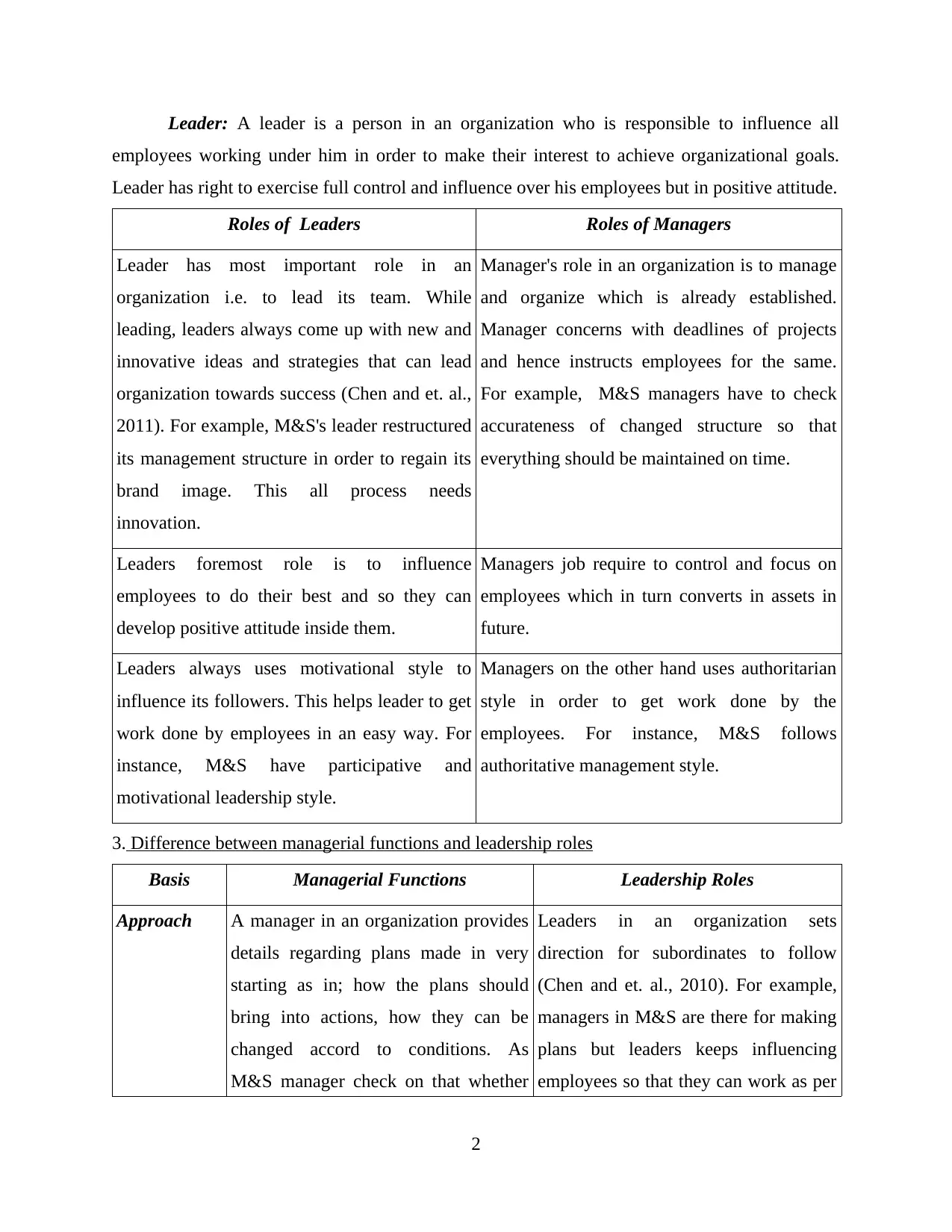
Leader: A leader is a person in an organization who is responsible to influence all
employees working under him in order to make their interest to achieve organizational goals.
Leader has right to exercise full control and influence over his employees but in positive attitude.
Roles of Leaders Roles of Managers
Leader has most important role in an
organization i.e. to lead its team. While
leading, leaders always come up with new and
innovative ideas and strategies that can lead
organization towards success (Chen and et. al.,
2011). For example, M&S's leader restructured
its management structure in order to regain its
brand image. This all process needs
innovation.
Manager's role in an organization is to manage
and organize which is already established.
Manager concerns with deadlines of projects
and hence instructs employees for the same.
For example, M&S managers have to check
accurateness of changed structure so that
everything should be maintained on time.
Leaders foremost role is to influence
employees to do their best and so they can
develop positive attitude inside them.
Managers job require to control and focus on
employees which in turn converts in assets in
future.
Leaders always uses motivational style to
influence its followers. This helps leader to get
work done by employees in an easy way. For
instance, M&S have participative and
motivational leadership style.
Managers on the other hand uses authoritarian
style in order to get work done by the
employees. For instance, M&S follows
authoritative management style.
3. Difference between managerial functions and leadership roles
Basis Managerial Functions Leadership Roles
Approach A manager in an organization provides
details regarding plans made in very
starting as in; how the plans should
bring into actions, how they can be
changed accord to conditions. As
M&S manager check on that whether
Leaders in an organization sets
direction for subordinates to follow
(Chen and et. al., 2010). For example,
managers in M&S are there for making
plans but leaders keeps influencing
employees so that they can work as per
2
employees working under him in order to make their interest to achieve organizational goals.
Leader has right to exercise full control and influence over his employees but in positive attitude.
Roles of Leaders Roles of Managers
Leader has most important role in an
organization i.e. to lead its team. While
leading, leaders always come up with new and
innovative ideas and strategies that can lead
organization towards success (Chen and et. al.,
2011). For example, M&S's leader restructured
its management structure in order to regain its
brand image. This all process needs
innovation.
Manager's role in an organization is to manage
and organize which is already established.
Manager concerns with deadlines of projects
and hence instructs employees for the same.
For example, M&S managers have to check
accurateness of changed structure so that
everything should be maintained on time.
Leaders foremost role is to influence
employees to do their best and so they can
develop positive attitude inside them.
Managers job require to control and focus on
employees which in turn converts in assets in
future.
Leaders always uses motivational style to
influence its followers. This helps leader to get
work done by employees in an easy way. For
instance, M&S have participative and
motivational leadership style.
Managers on the other hand uses authoritarian
style in order to get work done by the
employees. For instance, M&S follows
authoritative management style.
3. Difference between managerial functions and leadership roles
Basis Managerial Functions Leadership Roles
Approach A manager in an organization provides
details regarding plans made in very
starting as in; how the plans should
bring into actions, how they can be
changed accord to conditions. As
M&S manager check on that whether
Leaders in an organization sets
direction for subordinates to follow
(Chen and et. al., 2010). For example,
managers in M&S are there for making
plans but leaders keeps influencing
employees so that they can work as per
2
Paraphrase This Document
Need a fresh take? Get an instant paraphrase of this document with our AI Paraphraser
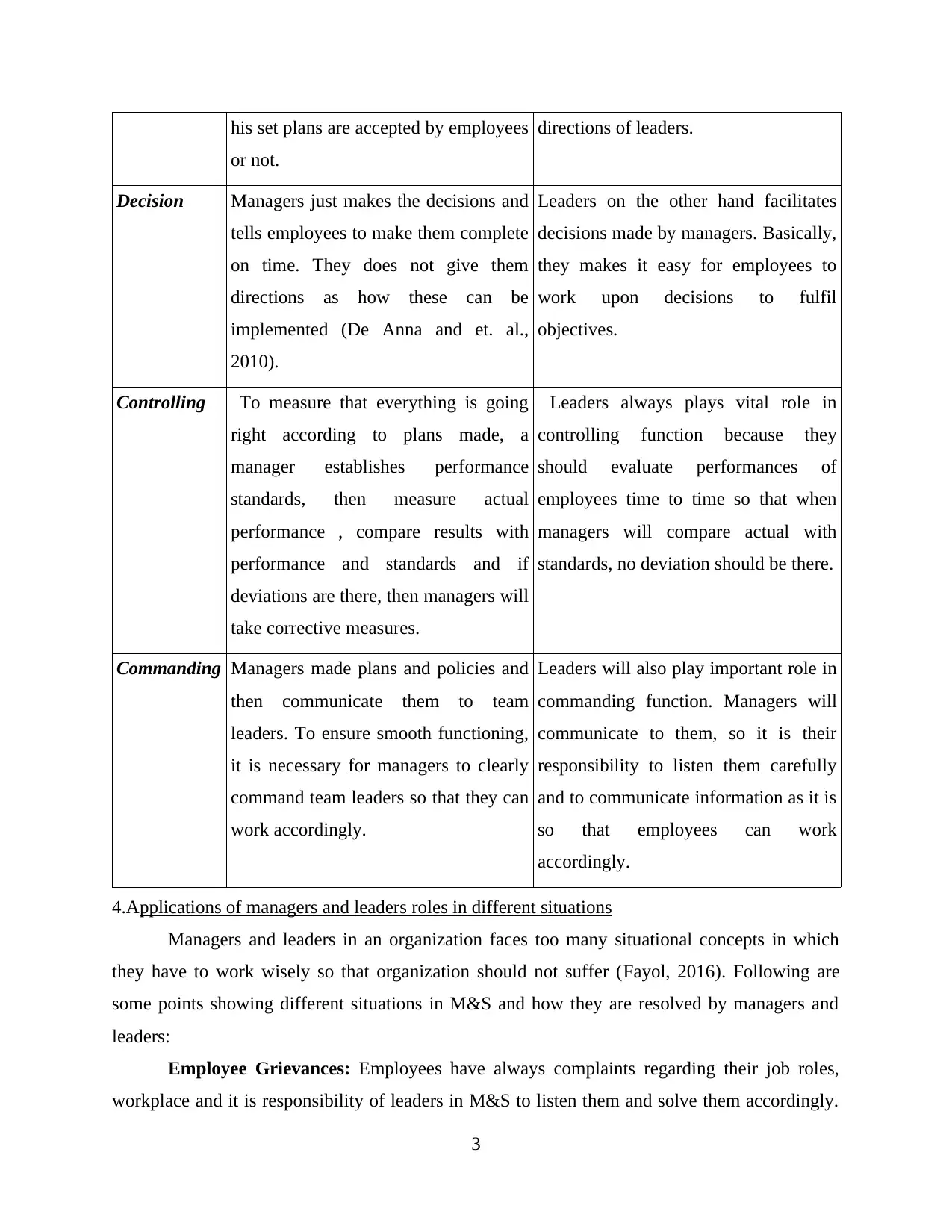
his set plans are accepted by employees
or not.
directions of leaders.
Decision Managers just makes the decisions and
tells employees to make them complete
on time. They does not give them
directions as how these can be
implemented (De Anna and et. al.,
2010).
Leaders on the other hand facilitates
decisions made by managers. Basically,
they makes it easy for employees to
work upon decisions to fulfil
objectives.
Controlling To measure that everything is going
right according to plans made, a
manager establishes performance
standards, then measure actual
performance , compare results with
performance and standards and if
deviations are there, then managers will
take corrective measures.
Leaders always plays vital role in
controlling function because they
should evaluate performances of
employees time to time so that when
managers will compare actual with
standards, no deviation should be there.
Commanding Managers made plans and policies and
then communicate them to team
leaders. To ensure smooth functioning,
it is necessary for managers to clearly
command team leaders so that they can
work accordingly.
Leaders will also play important role in
commanding function. Managers will
communicate to them, so it is their
responsibility to listen them carefully
and to communicate information as it is
so that employees can work
accordingly.
4.Applications of managers and leaders roles in different situations
Managers and leaders in an organization faces too many situational concepts in which
they have to work wisely so that organization should not suffer (Fayol, 2016). Following are
some points showing different situations in M&S and how they are resolved by managers and
leaders:
Employee Grievances: Employees have always complaints regarding their job roles,
workplace and it is responsibility of leaders in M&S to listen them and solve them accordingly.
3
or not.
directions of leaders.
Decision Managers just makes the decisions and
tells employees to make them complete
on time. They does not give them
directions as how these can be
implemented (De Anna and et. al.,
2010).
Leaders on the other hand facilitates
decisions made by managers. Basically,
they makes it easy for employees to
work upon decisions to fulfil
objectives.
Controlling To measure that everything is going
right according to plans made, a
manager establishes performance
standards, then measure actual
performance , compare results with
performance and standards and if
deviations are there, then managers will
take corrective measures.
Leaders always plays vital role in
controlling function because they
should evaluate performances of
employees time to time so that when
managers will compare actual with
standards, no deviation should be there.
Commanding Managers made plans and policies and
then communicate them to team
leaders. To ensure smooth functioning,
it is necessary for managers to clearly
command team leaders so that they can
work accordingly.
Leaders will also play important role in
commanding function. Managers will
communicate to them, so it is their
responsibility to listen them carefully
and to communicate information as it is
so that employees can work
accordingly.
4.Applications of managers and leaders roles in different situations
Managers and leaders in an organization faces too many situational concepts in which
they have to work wisely so that organization should not suffer (Fayol, 2016). Following are
some points showing different situations in M&S and how they are resolved by managers and
leaders:
Employee Grievances: Employees have always complaints regarding their job roles,
workplace and it is responsibility of leaders in M&S to listen them and solve them accordingly.
3

But alone leaders cannot solve complaints. Then, it is responsibility of managers of M&S to
organize complain management program to consider and communicate core grievances of
employees to leader.
Employee Turnover: It is so challenging situation to an organization when employee
turnover is high and specially of valued employees. It is responsibility of both managers and
leaders to provide employees happy workplace, better salaries in order to retain good and
valuable employees in M&S because company really needs good employees. Leaders in this
situation to retain employees, they can appreciate their work, reward their good work so that
employees can feel valued over there. Managers can create employment benefit programs to
retain employees because they feel satisfied at one place, they will not go anywhere.
Employee requests: Managers and leaders of M&S can listen to employee requests as
they can demand time offs, increased pay. Managers in this situation will plan and organize a
better wage system in regard of achieving business objectives. Leaders in this situation can
motivate them to work better so that they can enjoy benefits of increased pay.
5. Application of different management and leadership theories in M&S
Situational Leadership Theory: This theory states that same leadership style cannot be
applied in all the conditions and situations coming to an organization (Handschin and Petroianu,
2012). Leaders should change leadership style time to time, as per the situations so that
objectives can be met. As in M&S, leaders always make themselves prepared for new situations
so that they can cope up with contingencies as some stores of M&S was going in loss so leaders
thought to redesign their management structure.
Systems Leadership Theory: This theory states that leaders have to resolve their
leadership according to external environments and relationship with elements. Systems approach
clears about systematic way of doing work with dynamic elements and it also provides
framework for building ideas. For example, M&S leaders always follow systematic approach so
that they can meet external needs.
Contingency Theory: this theory provides clarification about leader's effectiveness in a
given situation. Basically, it focuses on leader that what type of leadership style it adopts in
coming up situations. For instance, M&S always make their leaders to be prepared because
contingencies can come anytime.
4
organize complain management program to consider and communicate core grievances of
employees to leader.
Employee Turnover: It is so challenging situation to an organization when employee
turnover is high and specially of valued employees. It is responsibility of both managers and
leaders to provide employees happy workplace, better salaries in order to retain good and
valuable employees in M&S because company really needs good employees. Leaders in this
situation to retain employees, they can appreciate their work, reward their good work so that
employees can feel valued over there. Managers can create employment benefit programs to
retain employees because they feel satisfied at one place, they will not go anywhere.
Employee requests: Managers and leaders of M&S can listen to employee requests as
they can demand time offs, increased pay. Managers in this situation will plan and organize a
better wage system in regard of achieving business objectives. Leaders in this situation can
motivate them to work better so that they can enjoy benefits of increased pay.
5. Application of different management and leadership theories in M&S
Situational Leadership Theory: This theory states that same leadership style cannot be
applied in all the conditions and situations coming to an organization (Handschin and Petroianu,
2012). Leaders should change leadership style time to time, as per the situations so that
objectives can be met. As in M&S, leaders always make themselves prepared for new situations
so that they can cope up with contingencies as some stores of M&S was going in loss so leaders
thought to redesign their management structure.
Systems Leadership Theory: This theory states that leaders have to resolve their
leadership according to external environments and relationship with elements. Systems approach
clears about systematic way of doing work with dynamic elements and it also provides
framework for building ideas. For example, M&S leaders always follow systematic approach so
that they can meet external needs.
Contingency Theory: this theory provides clarification about leader's effectiveness in a
given situation. Basically, it focuses on leader that what type of leadership style it adopts in
coming up situations. For instance, M&S always make their leaders to be prepared because
contingencies can come anytime.
4
⊘ This is a preview!⊘
Do you want full access?
Subscribe today to unlock all pages.

Trusted by 1+ million students worldwide
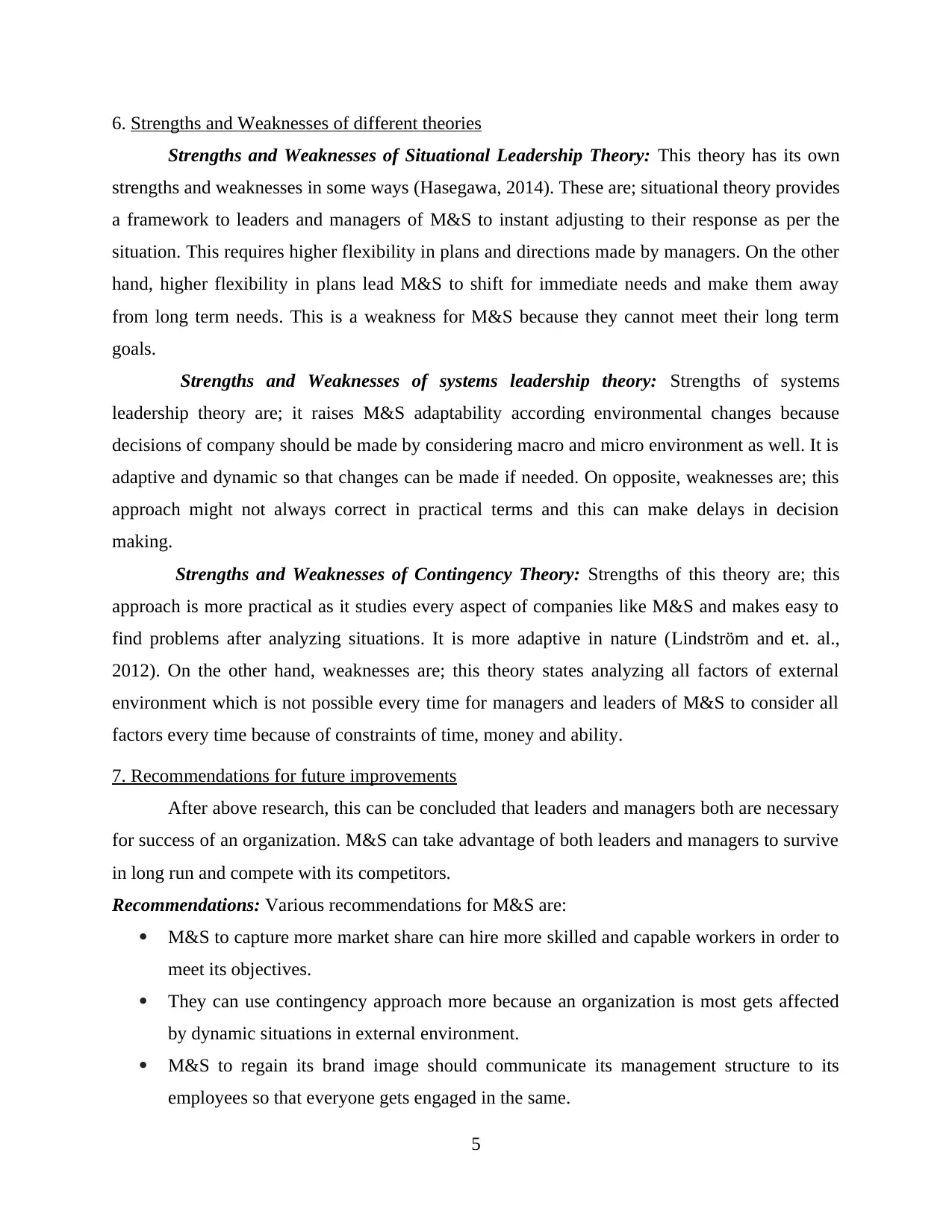
6. Strengths and Weaknesses of different theories
Strengths and Weaknesses of Situational Leadership Theory: This theory has its own
strengths and weaknesses in some ways (Hasegawa, 2014). These are; situational theory provides
a framework to leaders and managers of M&S to instant adjusting to their response as per the
situation. This requires higher flexibility in plans and directions made by managers. On the other
hand, higher flexibility in plans lead M&S to shift for immediate needs and make them away
from long term needs. This is a weakness for M&S because they cannot meet their long term
goals.
Strengths and Weaknesses of systems leadership theory: Strengths of systems
leadership theory are; it raises M&S adaptability according environmental changes because
decisions of company should be made by considering macro and micro environment as well. It is
adaptive and dynamic so that changes can be made if needed. On opposite, weaknesses are; this
approach might not always correct in practical terms and this can make delays in decision
making.
Strengths and Weaknesses of Contingency Theory: Strengths of this theory are; this
approach is more practical as it studies every aspect of companies like M&S and makes easy to
find problems after analyzing situations. It is more adaptive in nature (Lindström and et. al.,
2012). On the other hand, weaknesses are; this theory states analyzing all factors of external
environment which is not possible every time for managers and leaders of M&S to consider all
factors every time because of constraints of time, money and ability.
7. Recommendations for future improvements
After above research, this can be concluded that leaders and managers both are necessary
for success of an organization. M&S can take advantage of both leaders and managers to survive
in long run and compete with its competitors.
Recommendations: Various recommendations for M&S are:
M&S to capture more market share can hire more skilled and capable workers in order to
meet its objectives.
They can use contingency approach more because an organization is most gets affected
by dynamic situations in external environment.
M&S to regain its brand image should communicate its management structure to its
employees so that everyone gets engaged in the same.
5
Strengths and Weaknesses of Situational Leadership Theory: This theory has its own
strengths and weaknesses in some ways (Hasegawa, 2014). These are; situational theory provides
a framework to leaders and managers of M&S to instant adjusting to their response as per the
situation. This requires higher flexibility in plans and directions made by managers. On the other
hand, higher flexibility in plans lead M&S to shift for immediate needs and make them away
from long term needs. This is a weakness for M&S because they cannot meet their long term
goals.
Strengths and Weaknesses of systems leadership theory: Strengths of systems
leadership theory are; it raises M&S adaptability according environmental changes because
decisions of company should be made by considering macro and micro environment as well. It is
adaptive and dynamic so that changes can be made if needed. On opposite, weaknesses are; this
approach might not always correct in practical terms and this can make delays in decision
making.
Strengths and Weaknesses of Contingency Theory: Strengths of this theory are; this
approach is more practical as it studies every aspect of companies like M&S and makes easy to
find problems after analyzing situations. It is more adaptive in nature (Lindström and et. al.,
2012). On the other hand, weaknesses are; this theory states analyzing all factors of external
environment which is not possible every time for managers and leaders of M&S to consider all
factors every time because of constraints of time, money and ability.
7. Recommendations for future improvements
After above research, this can be concluded that leaders and managers both are necessary
for success of an organization. M&S can take advantage of both leaders and managers to survive
in long run and compete with its competitors.
Recommendations: Various recommendations for M&S are:
M&S to capture more market share can hire more skilled and capable workers in order to
meet its objectives.
They can use contingency approach more because an organization is most gets affected
by dynamic situations in external environment.
M&S to regain its brand image should communicate its management structure to its
employees so that everyone gets engaged in the same.
5
Paraphrase This Document
Need a fresh take? Get an instant paraphrase of this document with our AI Paraphraser
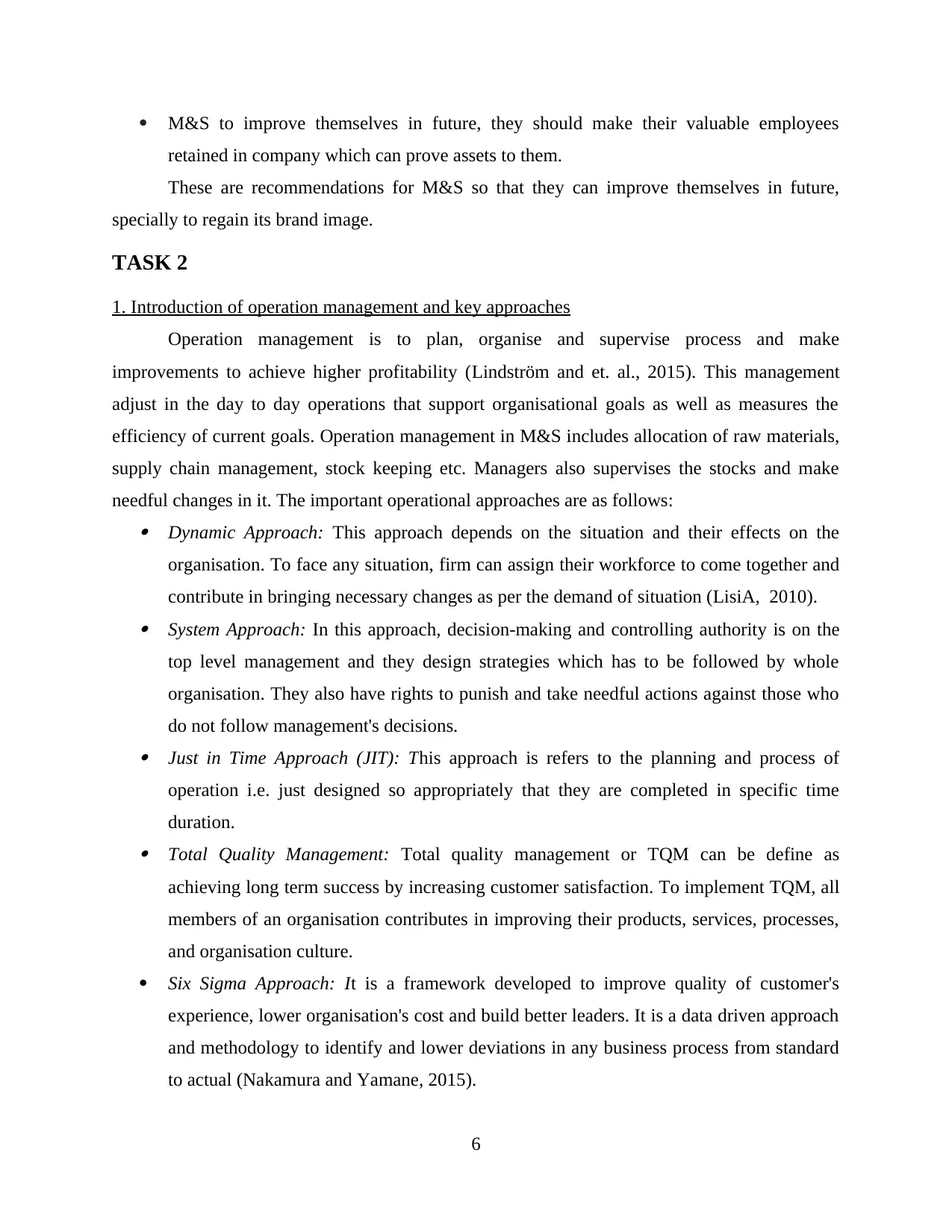
M&S to improve themselves in future, they should make their valuable employees
retained in company which can prove assets to them.
These are recommendations for M&S so that they can improve themselves in future,
specially to regain its brand image.
TASK 2
1. Introduction of operation management and key approaches
Operation management is to plan, organise and supervise process and make
improvements to achieve higher profitability (Lindström and et. al., 2015). This management
adjust in the day to day operations that support organisational goals as well as measures the
efficiency of current goals. Operation management in M&S includes allocation of raw materials,
supply chain management, stock keeping etc. Managers also supervises the stocks and make
needful changes in it. The important operational approaches are as follows: Dynamic Approach: This approach depends on the situation and their effects on the
organisation. To face any situation, firm can assign their workforce to come together and
contribute in bringing necessary changes as per the demand of situation (LisiA, 2010). System Approach: In this approach, decision-making and controlling authority is on the
top level management and they design strategies which has to be followed by whole
organisation. They also have rights to punish and take needful actions against those who
do not follow management's decisions. Just in Time Approach (JIT): This approach is refers to the planning and process of
operation i.e. just designed so appropriately that they are completed in specific time
duration. Total Quality Management: Total quality management or TQM can be define as
achieving long term success by increasing customer satisfaction. To implement TQM, all
members of an organisation contributes in improving their products, services, processes,
and organisation culture.
Six Sigma Approach: It is a framework developed to improve quality of customer's
experience, lower organisation's cost and build better leaders. It is a data driven approach
and methodology to identify and lower deviations in any business process from standard
to actual (Nakamura and Yamane, 2015).
6
retained in company which can prove assets to them.
These are recommendations for M&S so that they can improve themselves in future,
specially to regain its brand image.
TASK 2
1. Introduction of operation management and key approaches
Operation management is to plan, organise and supervise process and make
improvements to achieve higher profitability (Lindström and et. al., 2015). This management
adjust in the day to day operations that support organisational goals as well as measures the
efficiency of current goals. Operation management in M&S includes allocation of raw materials,
supply chain management, stock keeping etc. Managers also supervises the stocks and make
needful changes in it. The important operational approaches are as follows: Dynamic Approach: This approach depends on the situation and their effects on the
organisation. To face any situation, firm can assign their workforce to come together and
contribute in bringing necessary changes as per the demand of situation (LisiA, 2010). System Approach: In this approach, decision-making and controlling authority is on the
top level management and they design strategies which has to be followed by whole
organisation. They also have rights to punish and take needful actions against those who
do not follow management's decisions. Just in Time Approach (JIT): This approach is refers to the planning and process of
operation i.e. just designed so appropriately that they are completed in specific time
duration. Total Quality Management: Total quality management or TQM can be define as
achieving long term success by increasing customer satisfaction. To implement TQM, all
members of an organisation contributes in improving their products, services, processes,
and organisation culture.
Six Sigma Approach: It is a framework developed to improve quality of customer's
experience, lower organisation's cost and build better leaders. It is a data driven approach
and methodology to identify and lower deviations in any business process from standard
to actual (Nakamura and Yamane, 2015).
6
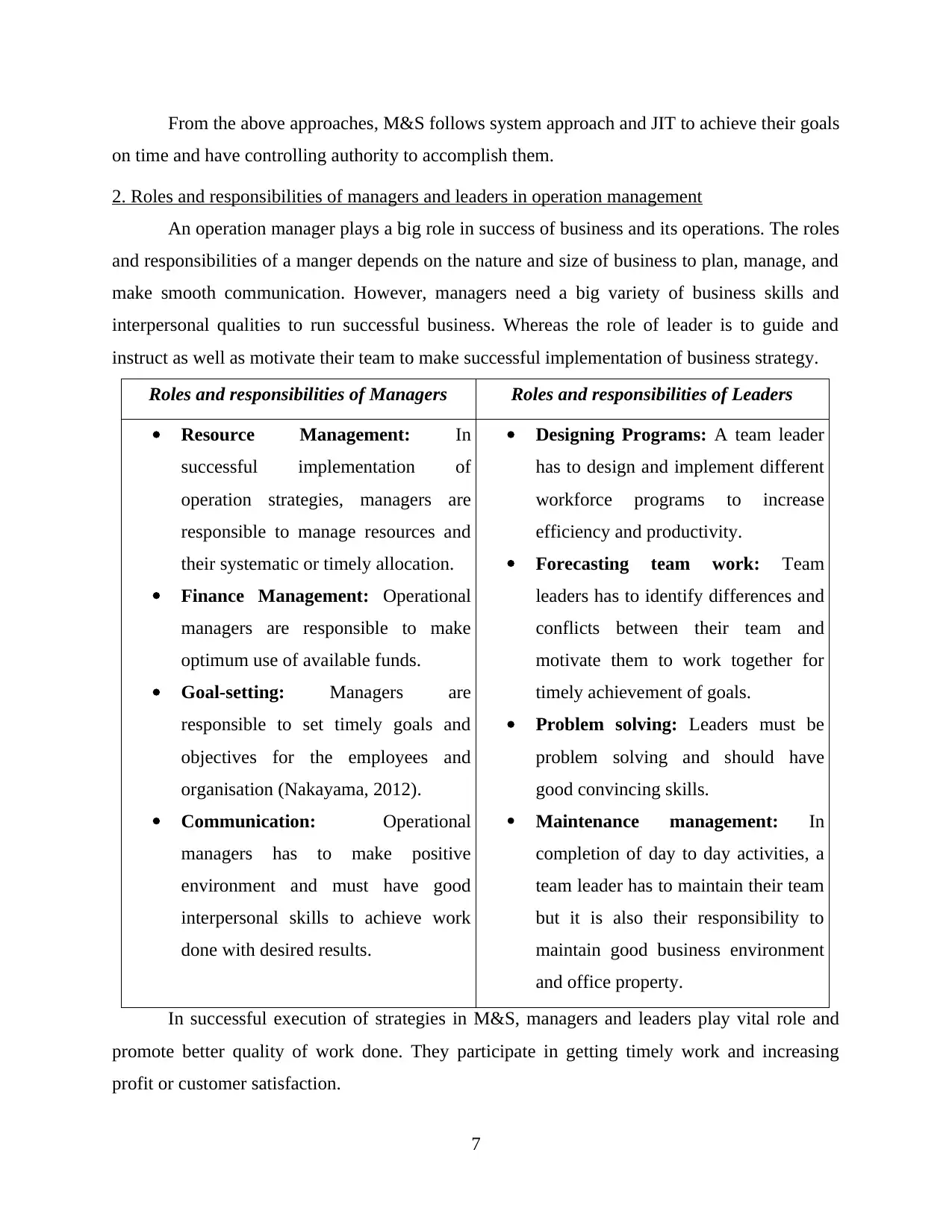
From the above approaches, M&S follows system approach and JIT to achieve their goals
on time and have controlling authority to accomplish them.
2. Roles and responsibilities of managers and leaders in operation management
An operation manager plays a big role in success of business and its operations. The roles
and responsibilities of a manger depends on the nature and size of business to plan, manage, and
make smooth communication. However, managers need a big variety of business skills and
interpersonal qualities to run successful business. Whereas the role of leader is to guide and
instruct as well as motivate their team to make successful implementation of business strategy.
Roles and responsibilities of Managers Roles and responsibilities of Leaders
Resource Management: In
successful implementation of
operation strategies, managers are
responsible to manage resources and
their systematic or timely allocation.
Finance Management: Operational
managers are responsible to make
optimum use of available funds.
Goal-setting: Managers are
responsible to set timely goals and
objectives for the employees and
organisation (Nakayama, 2012).
Communication: Operational
managers has to make positive
environment and must have good
interpersonal skills to achieve work
done with desired results.
Designing Programs: A team leader
has to design and implement different
workforce programs to increase
efficiency and productivity.
Forecasting team work: Team
leaders has to identify differences and
conflicts between their team and
motivate them to work together for
timely achievement of goals.
Problem solving: Leaders must be
problem solving and should have
good convincing skills.
Maintenance management: In
completion of day to day activities, a
team leader has to maintain their team
but it is also their responsibility to
maintain good business environment
and office property.
In successful execution of strategies in M&S, managers and leaders play vital role and
promote better quality of work done. They participate in getting timely work and increasing
profit or customer satisfaction.
7
on time and have controlling authority to accomplish them.
2. Roles and responsibilities of managers and leaders in operation management
An operation manager plays a big role in success of business and its operations. The roles
and responsibilities of a manger depends on the nature and size of business to plan, manage, and
make smooth communication. However, managers need a big variety of business skills and
interpersonal qualities to run successful business. Whereas the role of leader is to guide and
instruct as well as motivate their team to make successful implementation of business strategy.
Roles and responsibilities of Managers Roles and responsibilities of Leaders
Resource Management: In
successful implementation of
operation strategies, managers are
responsible to manage resources and
their systematic or timely allocation.
Finance Management: Operational
managers are responsible to make
optimum use of available funds.
Goal-setting: Managers are
responsible to set timely goals and
objectives for the employees and
organisation (Nakayama, 2012).
Communication: Operational
managers has to make positive
environment and must have good
interpersonal skills to achieve work
done with desired results.
Designing Programs: A team leader
has to design and implement different
workforce programs to increase
efficiency and productivity.
Forecasting team work: Team
leaders has to identify differences and
conflicts between their team and
motivate them to work together for
timely achievement of goals.
Problem solving: Leaders must be
problem solving and should have
good convincing skills.
Maintenance management: In
completion of day to day activities, a
team leader has to maintain their team
but it is also their responsibility to
maintain good business environment
and office property.
In successful execution of strategies in M&S, managers and leaders play vital role and
promote better quality of work done. They participate in getting timely work and increasing
profit or customer satisfaction.
7
⊘ This is a preview!⊘
Do you want full access?
Subscribe today to unlock all pages.

Trusted by 1+ million students worldwide

3. Importance and value of the key approaches
In achieving the organisational objectives successfully, the approaches of operation
management plays an important role as follows:
Timely Outcome: By successful implementation of operation approaches, an
organisation can achieve timely results of their desired goals and objectives (Neck and
Manz, 2010). After implementing these methods M&S can fulfil their goals on time and
as a result of which they will receive timely outcome.
Improves Quality: The above approaches can help in improving quality of product and
services offered by the organisation as well as quality of process included in it. By
implementing operational approaches M&S can improve the quality of products and
services they are delivering to their customers which will help in increasing customer
satisfaction. However customer satisfaction helps in increasing profit and brand loyalty
towards the company.
Increase Productivity: By contribution of all members of an organisation, its
productivity increases. The operational approaches need contribution of all employees as
well as management in its implementation. By establishing coordination and unity among
the employees of M&S the company can improve employees satisfaction and feeling of
equality and trust in them. This will also motivate employees to work more productively.
Teamwork: Operational approaches promote working in team or groups. To establish
successful implementation of operational strategies, the firm must ensure good
coordination between all teams and team members. Segmenting employees in teams
depending on their task or job role in M&S will help the company get their work done
more efficiently.
4. Effectiveness of managers and leaders improving operational efficiencies
In any small or large business unit, some common business objectives are emphasise in
its productivity, creation of employment and customers, development of human resource,
optimum use of resources, innovation, profit and supply management of goods etc. To attain
these objectives, managers and leaders at M&S participate in improving operational efficiencies
in following ways:
A manager direct and operates their employees to achieve set business target and leaders
at M&S to motivate their followers to contribute in accomplishing those targets.
8
In achieving the organisational objectives successfully, the approaches of operation
management plays an important role as follows:
Timely Outcome: By successful implementation of operation approaches, an
organisation can achieve timely results of their desired goals and objectives (Neck and
Manz, 2010). After implementing these methods M&S can fulfil their goals on time and
as a result of which they will receive timely outcome.
Improves Quality: The above approaches can help in improving quality of product and
services offered by the organisation as well as quality of process included in it. By
implementing operational approaches M&S can improve the quality of products and
services they are delivering to their customers which will help in increasing customer
satisfaction. However customer satisfaction helps in increasing profit and brand loyalty
towards the company.
Increase Productivity: By contribution of all members of an organisation, its
productivity increases. The operational approaches need contribution of all employees as
well as management in its implementation. By establishing coordination and unity among
the employees of M&S the company can improve employees satisfaction and feeling of
equality and trust in them. This will also motivate employees to work more productively.
Teamwork: Operational approaches promote working in team or groups. To establish
successful implementation of operational strategies, the firm must ensure good
coordination between all teams and team members. Segmenting employees in teams
depending on their task or job role in M&S will help the company get their work done
more efficiently.
4. Effectiveness of managers and leaders improving operational efficiencies
In any small or large business unit, some common business objectives are emphasise in
its productivity, creation of employment and customers, development of human resource,
optimum use of resources, innovation, profit and supply management of goods etc. To attain
these objectives, managers and leaders at M&S participate in improving operational efficiencies
in following ways:
A manager direct and operates their employees to achieve set business target and leaders
at M&S to motivate their followers to contribute in accomplishing those targets.
8
Paraphrase This Document
Need a fresh take? Get an instant paraphrase of this document with our AI Paraphraser
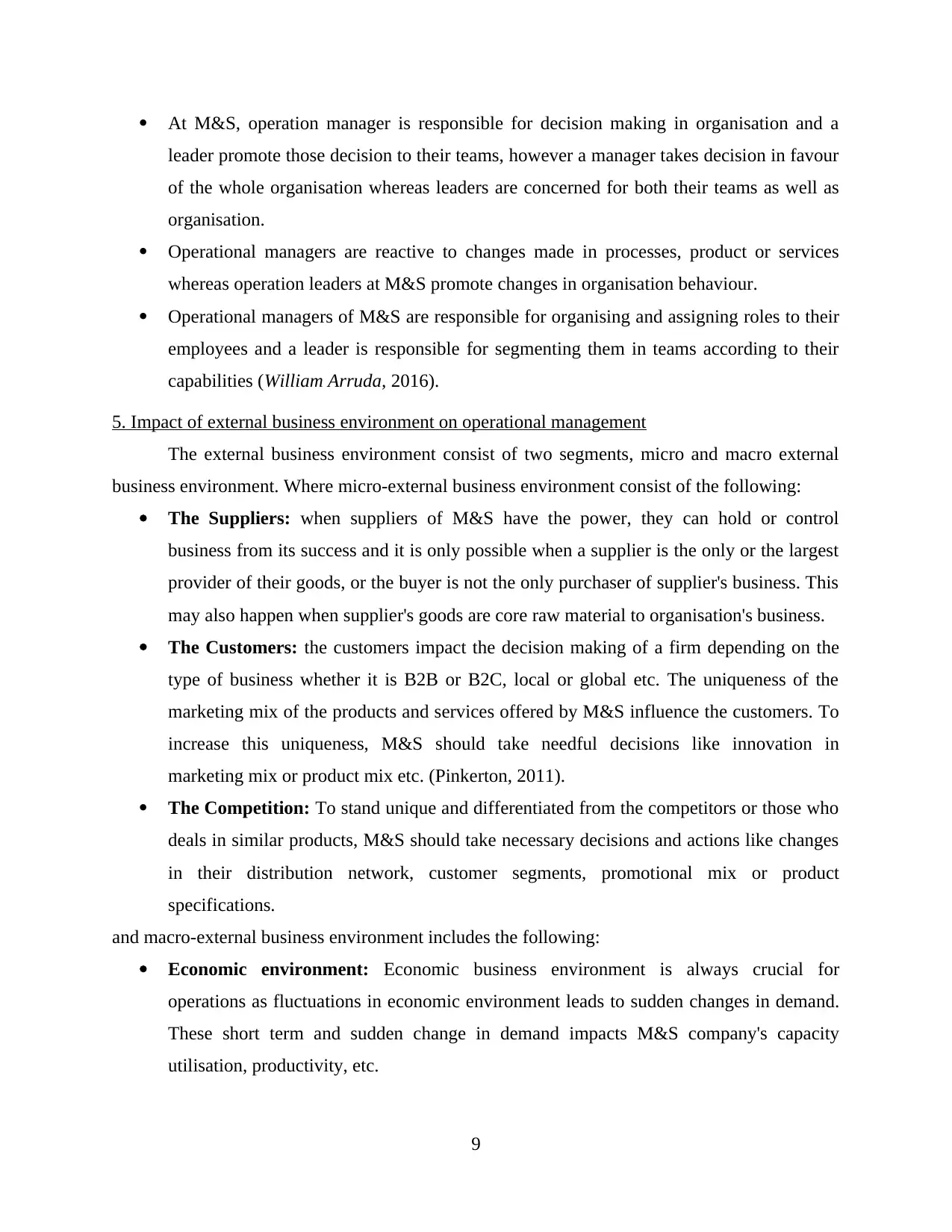
At M&S, operation manager is responsible for decision making in organisation and a
leader promote those decision to their teams, however a manager takes decision in favour
of the whole organisation whereas leaders are concerned for both their teams as well as
organisation.
Operational managers are reactive to changes made in processes, product or services
whereas operation leaders at M&S promote changes in organisation behaviour.
Operational managers of M&S are responsible for organising and assigning roles to their
employees and a leader is responsible for segmenting them in teams according to their
capabilities (William Arruda, 2016).
5. Impact of external business environment on operational management
The external business environment consist of two segments, micro and macro external
business environment. Where micro-external business environment consist of the following:
The Suppliers: when suppliers of M&S have the power, they can hold or control
business from its success and it is only possible when a supplier is the only or the largest
provider of their goods, or the buyer is not the only purchaser of supplier's business. This
may also happen when supplier's goods are core raw material to organisation's business.
The Customers: the customers impact the decision making of a firm depending on the
type of business whether it is B2B or B2C, local or global etc. The uniqueness of the
marketing mix of the products and services offered by M&S influence the customers. To
increase this uniqueness, M&S should take needful decisions like innovation in
marketing mix or product mix etc. (Pinkerton, 2011).
The Competition: To stand unique and differentiated from the competitors or those who
deals in similar products, M&S should take necessary decisions and actions like changes
in their distribution network, customer segments, promotional mix or product
specifications.
and macro-external business environment includes the following:
Economic environment: Economic business environment is always crucial for
operations as fluctuations in economic environment leads to sudden changes in demand.
These short term and sudden change in demand impacts M&S company's capacity
utilisation, productivity, etc.
9
leader promote those decision to their teams, however a manager takes decision in favour
of the whole organisation whereas leaders are concerned for both their teams as well as
organisation.
Operational managers are reactive to changes made in processes, product or services
whereas operation leaders at M&S promote changes in organisation behaviour.
Operational managers of M&S are responsible for organising and assigning roles to their
employees and a leader is responsible for segmenting them in teams according to their
capabilities (William Arruda, 2016).
5. Impact of external business environment on operational management
The external business environment consist of two segments, micro and macro external
business environment. Where micro-external business environment consist of the following:
The Suppliers: when suppliers of M&S have the power, they can hold or control
business from its success and it is only possible when a supplier is the only or the largest
provider of their goods, or the buyer is not the only purchaser of supplier's business. This
may also happen when supplier's goods are core raw material to organisation's business.
The Customers: the customers impact the decision making of a firm depending on the
type of business whether it is B2B or B2C, local or global etc. The uniqueness of the
marketing mix of the products and services offered by M&S influence the customers. To
increase this uniqueness, M&S should take needful decisions like innovation in
marketing mix or product mix etc. (Pinkerton, 2011).
The Competition: To stand unique and differentiated from the competitors or those who
deals in similar products, M&S should take necessary decisions and actions like changes
in their distribution network, customer segments, promotional mix or product
specifications.
and macro-external business environment includes the following:
Economic environment: Economic business environment is always crucial for
operations as fluctuations in economic environment leads to sudden changes in demand.
These short term and sudden change in demand impacts M&S company's capacity
utilisation, productivity, etc.
9

Technological environment: This factor is very significant and have high impact on
organisation's operational decision. This largely impacts in those products of M&S whose
life cycle are very short. This factor impact organisation decisions because innovation
and production processes are costly.
Legal and Environmental factors: These factors have high impact on operational
decisions as M&S has to adopt and follow regulations and legislation before designing,
processing and marketing their products. The products must not break or harm any legal
or environmental law.
Competitor's efficiency factors: Competitors efficiency of quick and better quality of
goods and services put pressure on M&S to deliver comparable performance in specific
time.
The above Micro and Macro factors affects M&S to make appropriate changes in their
marketing mix and decision making for it.
6. Application of operations management that impact on the wider business environment.
The application of operation management have major impact on the wider business
environment as it increases productivity of the business and improves quality of work. This
operation management also help in timely delivery of goods and services by optimum use of
resources and human efforts. This also enables to mange supply chain and bring needful changes
in product, services or processes to improve their quality and to stay in competition (Takeuchi,
2010). The M&S also take advantage by applying different management operations which helps
in balancing their inventory and other organisational processes.
7. Recommendations
The M&S company should use more operational techniques like TQM, six sigma etc for
better quality of work and timely deliverable serveries. The company should also communicate
their operational goals with their employees to promote team work and achieve their goals
timely. This will also help in improving satisfaction of their customers as well as their
employees.
CONCLUSION:
From the above report, it is concluded that managers and leaders play very crucial in the
success and development of an organization. For example; numerous business activities are
10
organisation's operational decision. This largely impacts in those products of M&S whose
life cycle are very short. This factor impact organisation decisions because innovation
and production processes are costly.
Legal and Environmental factors: These factors have high impact on operational
decisions as M&S has to adopt and follow regulations and legislation before designing,
processing and marketing their products. The products must not break or harm any legal
or environmental law.
Competitor's efficiency factors: Competitors efficiency of quick and better quality of
goods and services put pressure on M&S to deliver comparable performance in specific
time.
The above Micro and Macro factors affects M&S to make appropriate changes in their
marketing mix and decision making for it.
6. Application of operations management that impact on the wider business environment.
The application of operation management have major impact on the wider business
environment as it increases productivity of the business and improves quality of work. This
operation management also help in timely delivery of goods and services by optimum use of
resources and human efforts. This also enables to mange supply chain and bring needful changes
in product, services or processes to improve their quality and to stay in competition (Takeuchi,
2010). The M&S also take advantage by applying different management operations which helps
in balancing their inventory and other organisational processes.
7. Recommendations
The M&S company should use more operational techniques like TQM, six sigma etc for
better quality of work and timely deliverable serveries. The company should also communicate
their operational goals with their employees to promote team work and achieve their goals
timely. This will also help in improving satisfaction of their customers as well as their
employees.
CONCLUSION:
From the above report, it is concluded that managers and leaders play very crucial in the
success and development of an organization. For example; numerous business activities are
10
⊘ This is a preview!⊘
Do you want full access?
Subscribe today to unlock all pages.

Trusted by 1+ million students worldwide
1 out of 14
Related Documents
Your All-in-One AI-Powered Toolkit for Academic Success.
+13062052269
info@desklib.com
Available 24*7 on WhatsApp / Email
![[object Object]](/_next/static/media/star-bottom.7253800d.svg)
Unlock your academic potential
Copyright © 2020–2025 A2Z Services. All Rights Reserved. Developed and managed by ZUCOL.





